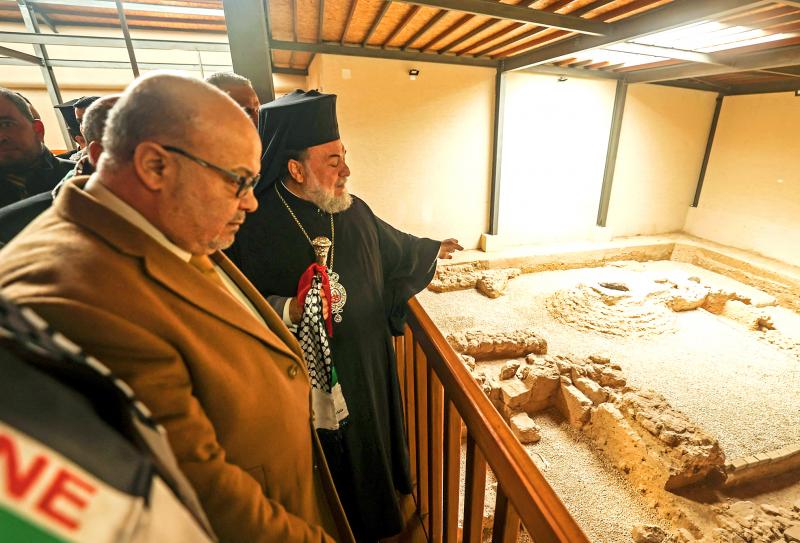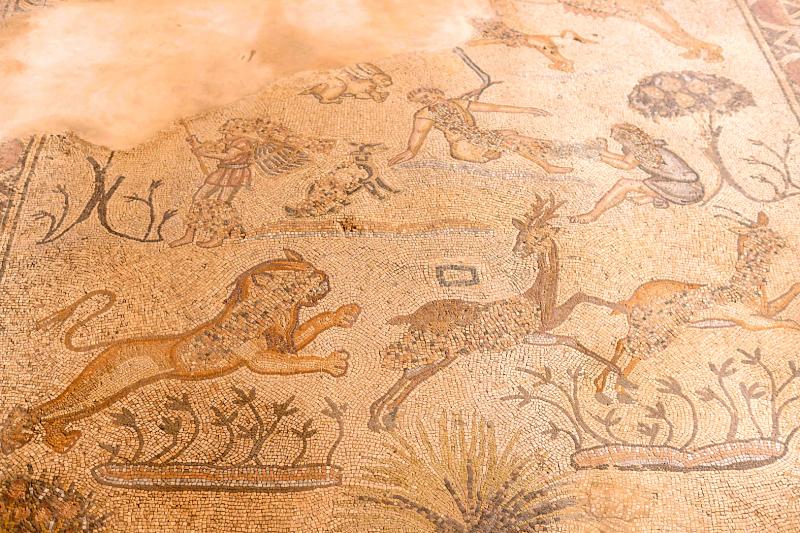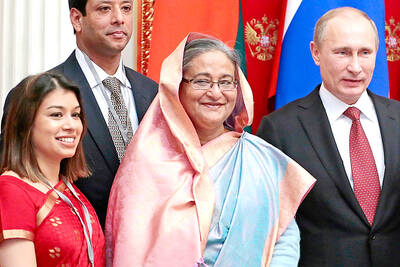The remains of a fifth-century Byzantine church were on Monday unveiled in Gaza following a three-year restoration project, with the Gaza Strip’s Hamas officials touting an embrace of their “Christian brothers.”
The remains of a church and monastery were first discovered in Jabalia, a city in northern Gaza, in 1997. Spanning an area about 800m2, the church’s floor is adorned with what officials said are “rare” mosaics, including depictions of animals, hunting scenes and palm trees.
Visitors can gaze at the mosaics from elevated wooden walkways.

Photo: AFP
The Gaza Ministry of Tourism said the church’s original walls were adorned with religious texts written in ancient Greek dating from the era of Emperor Theodosius II, who ruled Byzantium from 408 to 450.
At a ceremony marking the site’s reopening, the most senior Christian cleric in Gaza, Archbishop Alexios of Tiberias, talked about Christianity’s long history in the coastal territory, saying that “monasticism began in the Gaza strip in the year 280.”
However, the number of Christians in Gaza has been falling for years, many of them having emigrated, particularly after the Islamist Hamas movement seized power in 2007.

Photo: AFP
Local church officials said only about 1,000 Christians remain in the enclave, down from 7,000 in 2007.
Issam al-Daalis, president of the Governing Committee for the Management of Gaza Issues, said that the site’s restoration is an example of Hamas’ “embracing” of its “Christian brothers in Gaza.”
The restoration was carried out by French organization Premiere Urgence Internationale at a cost of nearly US$250,000. The British Council also supported the work.
About 2.3 million people live in Gaza, which has been blockaded by Israel since 2007.

Incumbent Ecuadoran President Daniel Noboa on Sunday claimed a runaway victory in the nation’s presidential election, after voters endorsed the young leader’s “iron fist” approach to rampant cartel violence. With more than 90 percent of the votes counted, the National Election Council said Noboa had an unassailable 12-point lead over his leftist rival Luisa Gonzalez. Official results showed Noboa with 56 percent of the vote, against Gonzalez’s 44 percent — a far bigger winning margin than expected after a virtual tie in the first round. Speaking to jubilant supporters in his hometown of Olon, the 37-year-old president claimed a “historic victory.” “A huge hug

Two Belgian teenagers on Tuesday were charged with wildlife piracy after they were found with thousands of ants packed in test tubes in what Kenyan authorities said was part of a trend in trafficking smaller and lesser-known species. Lornoy David and Seppe Lodewijckx, two 19-year-olds who were arrested on April 5 with 5,000 ants at a guest house, appeared distraught during their appearance before a magistrate in Nairobi and were comforted in the courtroom by relatives. They told the magistrate that they were collecting the ants for fun and did not know that it was illegal. In a separate criminal case, Kenyan Dennis

A judge in Bangladesh issued an arrest warrant for the British member of parliament and former British economic secretary to the treasury Tulip Siddiq, who is a niece of former Bangladeshi prime minister Sheikh Hasina, who was ousted in August last year in a mass uprising that ended her 15-year rule. The Bangladeshi Anti-Corruption Commission has been investigating allegations against Siddiq that she and her family members, including Hasina, illegally received land in a state-owned township project near Dhaka, the capital. Senior Special Judge of Dhaka Metropolitan Zakir Hossain passed the order on Sunday, after considering charges in three separate cases filed

APPORTIONING BLAME: The US president said that there were ‘millions of people dead because of three people’ — Vladimir Putin, Joe Biden and Volodymyr Zelenskiy US President Donald Trump on Monday resumed his attempts to blame Ukrainian President Volodymyr Zelenskiy for Russia’s invasion, falsely accusing him of responsibility for “millions” of deaths. Trump — who had a blazing public row in the Oval Office with Zelenskiy six weeks ago — said the Ukranian shared the blame with Russian President Vladimir Putin, who ordered the February 2022 invasion, and then-US president Joe Biden. Trump told reporters that there were “millions of people dead because of three people.” “Let’s say Putin No. 1, but let’s say Biden, who had no idea what the hell he was doing, No. 2, and